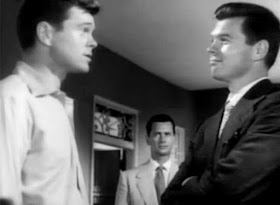NIAGARA (1953). Director: Henry Hathaway.
"For a dress like [Monroe's], you better start making plans at about 13." -- Polly.
A young couple on their honeymoon, Polly (Jean Peters) and Ray (Max Showalter aka Casey Adams), become entwined with another couple staying at the same cabins near the falls. George Loomis (Joseph Cotten) is unaware that his wife, Rose (Marilyn Monroe), has taken a darkly handsome lover, Ted (Richard Allan), and that Rose wants this younger man to murder George. However, the best laid plans ... The actions of some of the characters in this are pretty dumb, but the movie is not boring. Monroe [Love Happy] looks sensational, although she's given better performances elsewhere. Cotten [September Affair] and Peters are fine, but Showalter's golly-gee-whiz attitude quickly grows tiresome, and he's not very good. The picture has an exciting, if somewhat abrupt, climax on the falls. Don Wilson and Lurene Tuttle are fine as Ray's associate and his wife. Very good use of Niagara locations. Peters and Showalter were both in Vicki.
Verdict: Monroe sizzles sexily while those waters keep rushing! ***.
"For a dress like [Monroe's], you better start making plans at about 13." -- Polly.
A young couple on their honeymoon, Polly (Jean Peters) and Ray (Max Showalter aka Casey Adams), become entwined with another couple staying at the same cabins near the falls. George Loomis (Joseph Cotten) is unaware that his wife, Rose (Marilyn Monroe), has taken a darkly handsome lover, Ted (Richard Allan), and that Rose wants this younger man to murder George. However, the best laid plans ... The actions of some of the characters in this are pretty dumb, but the movie is not boring. Monroe [Love Happy] looks sensational, although she's given better performances elsewhere. Cotten [September Affair] and Peters are fine, but Showalter's golly-gee-whiz attitude quickly grows tiresome, and he's not very good. The picture has an exciting, if somewhat abrupt, climax on the falls. Don Wilson and Lurene Tuttle are fine as Ray's associate and his wife. Very good use of Niagara locations. Peters and Showalter were both in Vicki.
Verdict: Monroe sizzles sexily while those waters keep rushing! ***.

























